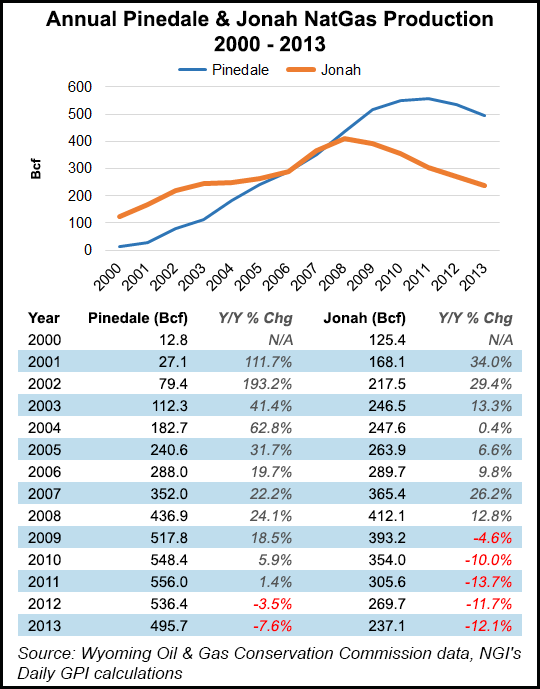Regulatory | NGI All News Access
Ozone Plan For Wyoming Air Board Gains Momentum
In an action watched closely by oil and natural gas interests, the Wyoming Air Quality Advisory Board in the Department of Environmental Quality (DEQ) on Wednesday approved measures intended to reduce smog and improve air quality in the state’s Upper Green River Basin ozone nonattainment area.

If the changes are adopted by the Wyoming Environmental Quality Council next year, the proposal would require oil and gas operators to adopt what the Environmental Defense Fund (EDF), a major player on this issue, considers “sensible, cost-effective measures,” including regular leak detection inspections on existing well sites and compressor stations to reduce regional air pollution.
Earlier this year, an ad hoc report by a minority of a 28-member governor’s task force said that while the industry was making progress in combating ozone at new oil/gas drilling sites, older sites were being left to pollute (see Daily GPI, March 21). The task force’s recommendations were adopted by the state’s DEQ and the task force subsequently disbanded (see Daily GPI, Sept. 24, 2012).
“These new rules are a significant step toward reducing leaks from oil and gas equipment and helping restore healthy air to the citizens of Pinedale and surrounding communities,” said Jon Goldstein, EDF senior energy policy manager.
Goldstein maintains that the latest action is the first time that Wyoming has moved forward with rules targeting older, existing sources of oil/gas pollution, which he called “a strong precedent” as other areas deal with the impacts from increased oil/gas drilling activity with the shale boom.
Wyoming has been working to plug many old wells.The state’s oil and gas regulator last month seized close to 3,000 idle coalbed methane wells when High Plains Gas Inc. failed to come up with a $6.8 million bond, essentially doubling an ongoing effort to plug abandoned oil/gas wells (see Daily GPI, Nov. 19).
EDF sees room for improvement in the five-member advisory board’s proposed changes in the state air quality standards and regulations. But for now, Goldstein endorsed many aspects of the proposed changes as “demonstrating Wyoming’s tradition of national leadership on clean air measures for oil/gas activities.”
Similarly, the Petroleum Association of Wyoming (PAW) is monitoring the developments and continues to work on regulations aimed at reducing ozone, PAW Vice President John Robitaille told NGI Wednesday. “Potentially, they could help remove the [federal] nonattainment status,” Robitaille said.
“While the [revised rules] being forwarded [by the advisory board] are improving, we believe room exists for further clarification,” Robitaille said. “We do not oppose these rules, and we are preparing to continue to work for clear and concise rules that allow for continued [oil/gas] development in the [Upper Green River Basin] area.”
Natural gas production in the Pinedale Anticline and the adjacent Jonah field, the two largest producing fields in Wyoming, has declined in recent years, according to Wyoming Oil & Gas Conservation Commission data.
© 2024 Natural Gas Intelligence. All rights reserved.
ISSN © 1532-1231 | ISSN © 2577-9877 |
